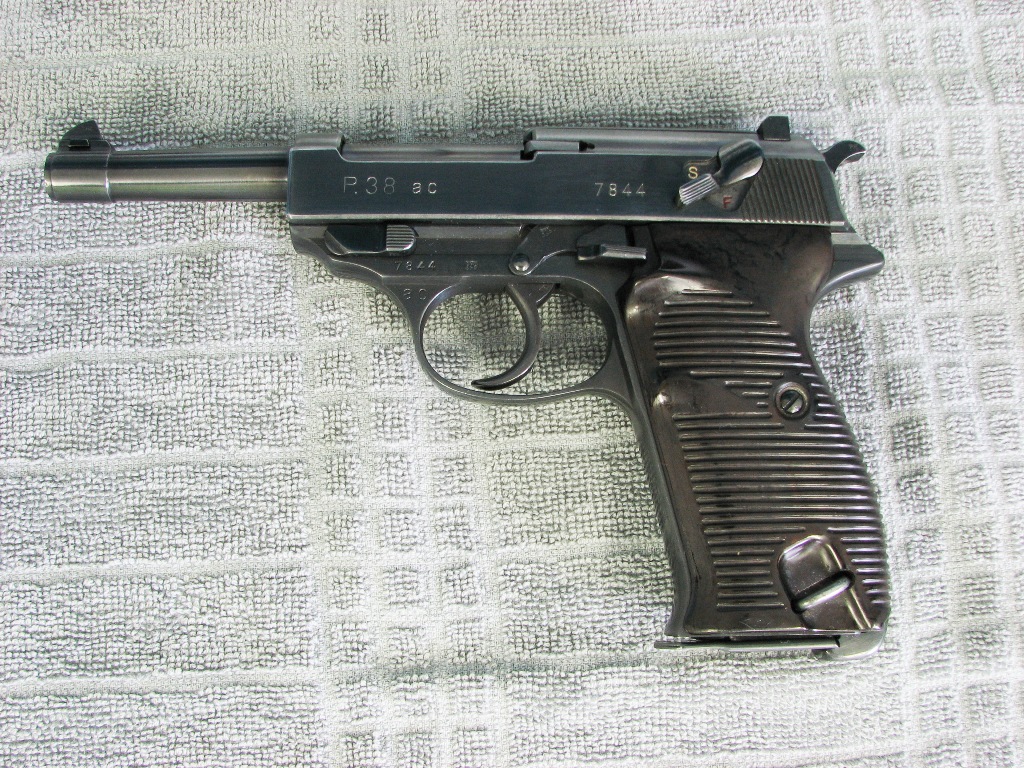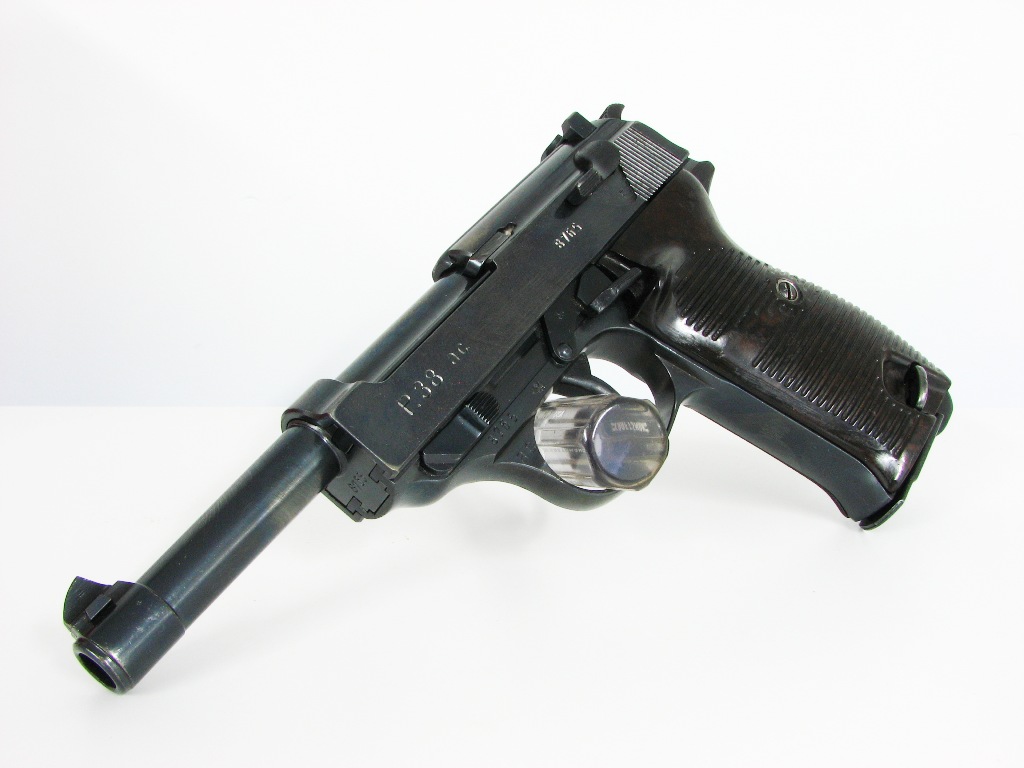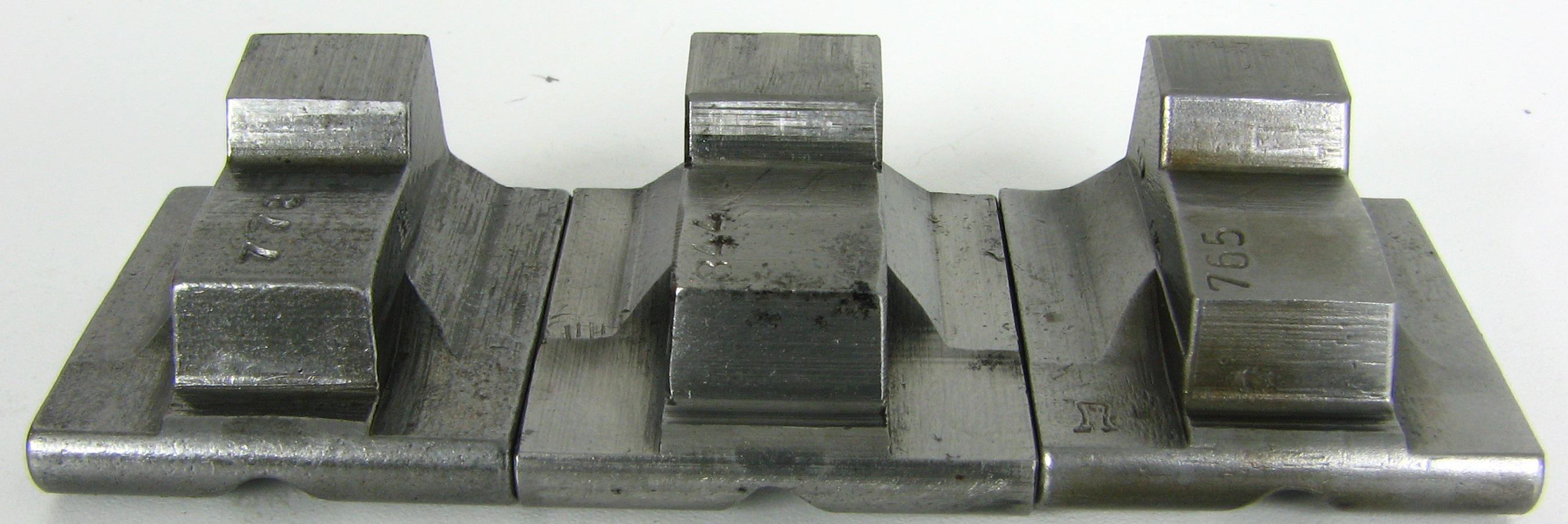The "ac no-date"
Original, restored, and faked.
![]()
Produced for a little over a month in 1940 in a quantity of about 2500, the ac no-date is one of the harder variations to find, especially in a condition that collectors desire. After five years of war and 60+ more years of use or abuse, most are not in pristine condition. Like any rare pistol (or just about anything rare or valuable), it becomes the target of deception artists. Below are three ac no-date pistols. One is original, one has been restored (refinished), and one is an outright fake.
Serial number 9778 is in a condition typical of a pistol that saw use throughout the entire duration of World War II. While its finish is quite worn, the action is still tight and the bore is excellent. It retains its original configuration except for the matching magazines. Almost every small part is stamped with the German acceptance stamp (e/359) with the exception of the springs and the sear and hammer pins. All serialized parts match: frame, barrel, slide, locking block, and grips.
Serial number 7844 has been restored but still has all matching serial numbers (less the magazine), and all appropriate small parts bear the acceptance marking.

Serial number 8765 is a complete fake. It is made of World War II parts, but several P.38 experts have examined this pistol and have determined every serialized component has been re-stamped to make a "matching" gun. Unfortunately this pistol was passed off as legitimate. Examining this pistol closely reveals some of the errors made by the unscrupulous individual who produced this fake.

The first and most obvious is the fact the right grip is made by Julius Posselt, and is over two years too early to appear on a pistol made in 1940 (this grip would be most appropriate on a pistol manufactured by Spreewerk). Even more interesting is the fact the the right grip has a poor attempt at a Walther acceptance marking on the inside. The Julius Posselt grip can be identified by the five "broken lines" around the grip screw, vice the six broken line style used by the other manufacturers.
Next, not all small parts are acceptance marked as they should be, although most are. Some of the incorrect parts are visible without any disassembly of the pistol (the hammer and the decocker/safety lever), while the others would require some disassembly of the pistol to see that they lack the e/359 marking (the sear, ejector, firing pin retaining pin, and firing pin lock lifter). The finish of the hammer is not the high-gloss blue found on the early Walther pistols - it came from a mid to late-war pistol.
Finally, all of the serial numbers have been re-stamped to match. It should be noted that in addition to committing fraud by passing this pistol off as legitimate (assuming the seller did so knowingly), the ATF takes a dim view of re-stamping the frame/receiver serial number of any firearm, even if the original number is re-stamped. It is a felony to deface or change the frame serial number.
The following pictures allow a comparison of the size and font of the component serial numbers. Note that the number 7 has a "tail" on the upper left part of the digit in the Times New Roman style font, vice the correct Arial style font. The frame serial numbers are seen below (click on the thumbnails to enlarge).
In addition to the font issue, the numbers on the faked slide are noticeably smaller than is correct.
The same font problem is seen on the barrel serial numbers.

Since an unserialized slide is hard to come by, the old serial number on pistol 8765 was removed by buffing or grinding. As a result, the left side slide rail is thinner than the right. This can be seen by the naked eye when the slide is removed and viewed upside-down. Measuring the slide with a micrometer verifies this.
|
|
|
|||||||||
|
|
|
|
|||||||||
An easy check that does not require any measurement or even removing the slide from the pistol is to check the clearance between the slide and the safety/decocker lever. Notice the much larger gap on the fake pistol because so much metal was removed from the slide when obliterating the old serial number.
Another clue is that when the original serial number was removed from the fake slide, it produced a sharp edge at the top of the left vertical surface of the slide. The other pistols have a much more rounded contour (as does the right side of the fake slide) where the side of the slide transitions to the rounded top half.
|
|
|
|||||||||
|
|
|
|
|||||||||
While un-numbered "armorer's spare" barrels are much easier to come by than un-numbered frames or slides, it appears here too a serial number was removed as evidenced by the measurements below.
The locking block suffered a similar fate - its old number was ground off and a new one stamped (once again in the wrong front). Note the polished area where the serial number is stamped on the right side block.

Click here for larger picture of the locking blocks.
Here are a few more comparison pictures.
In summary, while pistol serial number 8765 is an interesting study in counterfeiting, it is worth no more than "shooter" price for use as a range gun or display piece. The majority of the signs that reveal this pistol to be a fake would be hard to see without a hands-on disassembly inspection (there were other signs that were not detailed in this article - no need to aid future counterfeiters). Some could be spotted if the pistol were for sale on-line and had excellent, detailed pictures. Unfortunately, this is not always the case. When buying a high-end pistol such as this one was alleged to be, the buyer should view the pistol in person if at all possible. If not, demand an inspection period. Caveat emptor!
![]()